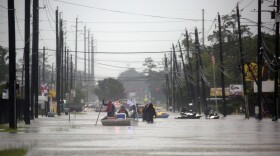Hyperloop technology promises to shuttle people in capsules from Dallas to Austin in 19 minutes. How? Through passenger pods traveling at up to 700 miles per hour through a low-pressure tube.
Texas emerged as one of 10 winners in the recent Hyperloop One Global Challenge. Steven Duong, a Dallas-based urban designer who helped write that plan, says the Hyperloop is not as far-fetched as it sounds.
Interview Highlights: Steven Duong
On how he would describe the Hyperloop:
"The best way I can describe it is a combination of a couple of things: One, the pneumatic tubes at the banks. Upscale that to the size of a regular train system. Now, bring in the good parts of other transportation systems like high-speed rail.
"As far as the actual experience on the rider, imagine honestly just flying in a plane. Take the fuselage of an airplane, cut off the wings, bring it down to the surface of the earth. Now, bring down the low-pressure environment of the atmosphere down to the earth by putting it in a tube. That's what you're really doing with Hyperloop; you're retrofitting the best parts of other different modes of transportation and putting it into something new."
On why he and his team focused on moving freight in their Hyperloop design:
"I think part of the reason why Texas was selected as a winner was because of the emphasis on passenger and freight. We're hoping to connect the Port Authority of Houston, which is the one of the biggest seaports on the eastern coast of the U.S. with the Inland Port of Laredo, which is one of the busiest inland ports in North America to bring goods from Mexico and Latin America into the states along with the various airports in the major cities. We can connect the rest of the Texas Triangle, which is Dallas, Austin, Houston, San Antonio and Laredo, that high-speed rail isn't connecting."
On why Texas would be an ideal place for the Hyperloop:
"We actually lead the country in what we call 'super commuters'....[they're] individuals who travel long distances across cities very frequently for either leisure or work. The actual physical distance between the cities make a lot of sense. For airlines, it's not particularly efficient for them to burn all that energy, fuel and time to get into the air. You spend hardly any time actually in the air cruising at the optimal height. [Texas is also] really flat. Actually, constructing a technology like this would be easier than it would be in mountains, rivers and lakes. We [also have] strong economic growth and population growth in Texas, which gives a potential future market for Hyperloop to actually tap into."
On what he would say to people who think Hyperloop is a far-fetched idea:
"We're not used to moving through something like the Hyperloop yet, but we are comfortable with flying, and honestly, the experience isn't that much different from flying or hopping in a train; it's just a combination of a couple of those elements. You know, people think it's crazy, but we also said the same thing when people began flying, moving in trains. I think people will pick up on Hyperloop fairly quickly once they see it working."
Steven Duong is an urban designer with AECOM, an engineering, design and construction firm with offices in Dallas.







